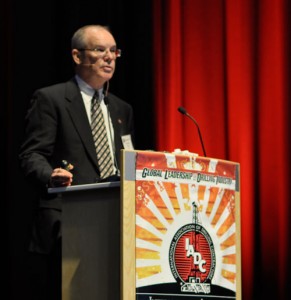ART, DSATS groups push ahead with automation integration projects

The IADC Advanced Rig Technology (ART) Committee and the SPE Drilling Systems Automation Technical Section (DSATS) continue to work on advancing the development of drilling automation through the interface of WITS-based downhole tools with OPC-based surface drilling control systems. Terry Loftis, vice chairman of the ART Drilling Control Systems (DCS) Subcommittee, provided an update of both groups’ activities at the IADC World Drilling 2011 Conference & Exhibition last week in Copenhagen, Denmark.
“In 2009/2010, the DCS Subcommittee for IADC began to explore the merits of integrating an emerging open connectivity data protocol known as OPC-UA, or Unified Architecture, with surface drilling systems and subsequently interfacing that protocol with the Well-site Information Transfer Specification protocol, more commonly known as WITS protocol, combining those two to try and develop a communications data link,” said Mr Loftis, engineering manager – DP, instrumentation and controls for Transocean.
At the same time, work was already under way at DSATS to accomplish the same task. Their team was focused on defining the nomenclature, syntax and data structure required to accurately transfer control data.
“In early 2010, these IADC and SPE subcommittees combined forces to expedite definition, implementation and initial testing of a jointly developed interface between surface drilling systems and downhole instrumentation systems,” Mr Loftis said.
To give credit where credit is due, Mr Loftis said that it is DSATS that has accomplished the majority of the work done thus far. The group has completed phase one of its objectives, where it identified and defined key interface points to equipment on the rig and agreed on a list of tag names for the key interface points for use in communication protocols. Also during this phase, OPC-UA gained overwhelming acceptance, and all work is now proceeding on the WITSML-OPC-UA model.
“Phase two is nearing completion with an effort to demonstrate the architecture by implementing a prototype – components and architecture that control, limit and detect alarms on the top drive simulator. Participants from many companies are working towards this objective from the standpoint of service companies, drilling contractors and original equipment manufacturers,” Mr Loftis said. If all goes well, the model should be ready to be demonstrated in time for the SPE Annual Technical Conference & Exhibition, 30 October to 2 November, in Denver, Colo.
On the IADC side, at the most recent DCS meeting, a breakdown of the Task Specific Work Groups was developed where IADC expertise can be applied to fill gaps within this collaborative body of work with DSATS. There are already volunteers for three of the four work groups, and Mr Loftis said he is still seeking one more service company volunteer for the “transfer of tool ownership” work group.
To get involved with the IADC DCS group, their next meeting will be held at the IADC Houston office on 12 July.
To read more about the collaboration between the IADC ART Committee and the SPE DSATS, click here.




